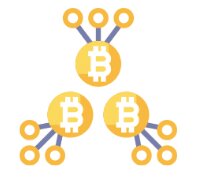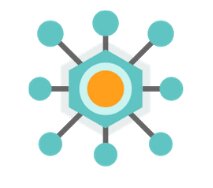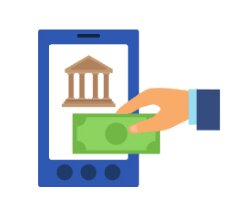Decentralization in Blockchain
The Model of Decentralization in Blockchain is the distribution of dependency and control of decision-making from a centralized point of contact to the respective network nodes. Decentralization aims to reduce the level of trust, responsibility, and dependency on a central entity. And distribute it to other participants in the network with equal power and control to all.
Centralized systems have been ruling the world for a long time. Call it the monarchy of a king or tech giants ruling the industry with customer data. Similarly, our solar system itself is bound to a centralized star known as the Sun. However, Is centralization a way to keep everything synchronized? Or just a matter of importance given to a centralized entity? What if the control and responsibilities are delegated to a distributed network?
Above all, let’s thoroughly understand decentralization and its corresponding pros and cons.
Table of Content
Best-suited Blockchain courses for you
Learn Blockchain with these high-rated online courses
What is Decentralization?
In general, decentralization is about moving the power and authority away from one central entity. And make the power available to the respective member of the community.
Therefore, below are the points to focus on decentralization:
- No central Authority
- Community members have equal authority
- Shared power
For instance, BitTorrent. It’s a peer-to-peer file-sharing system that doesn’t depend on a server exclusively. Moreover, BitTorrent is a cloud-based system that anyone can join without permission.
Above all, Let’s jot down the advantages of a decentralized system.
- The system is less likely to fail. Especially, when it’s based on redundant and shared components.
- Hard to attack as all users are not present in one place.
- Participants or nodes can come and go. Yet, the system will remain strong and independent.
- Users or participants gets value as a respective part of the network.
What is Decentralization in Blockchain?
Blockchain is a decentralized peer-to-peer network. It provides an efficient way to work with unknown parties without trusting each other. Blockchain is a transparent and immutable (data can’t be modified later) network that enables append-only records. Therefore, it’s easier and more secure to share information among different parties.

In the case of Decentralization in Blockchain. Firstly, power decentralization takes place politically as no central entity controls the system.
Secondly, Blockchain decentralization happens on the architectural level. Now, the infrastructure has no single point of failure. Each node has exact same copy of the information as another node. Even if one system is tampered with, there will be other nodes to regulate the flow of information. Moreover, a single node with change can easily be pointed out.
For instance, If one node stops responding or gets corrupted. Still, there will be other 99 nodes that ensure the survival and continuity of the network. Moreover, A blockchain network wouldn’t completely shut down even if the whole country’s power went off. Hence, that makes blockchain more resilient and powerful as a network.
Why is Decentralization important?
Centralization ends up giving power and makes us dependent on a single entity.
For instance, companies like Facebook, and Amazon finding new ways to earn from user data and behavior. In addition, customers generally think of services provided to them as a product and they are consumers using it. However, the situation is the opposite. Companies see consumers as a product and find out ways to monetize their data and habits. Therefore, the consumer and their data are what is being sold.
In contrast, decentralization puts the value and data independence back in the hands of consumers. This is an important shift in thinking about how a system can operate?
First, let’s understand the major differences between centralized and decentralized systems.
Centralization VS Decentralization
This section differentiates between centralization and Decentralization based on various criteria.
| Centralization | Decentralization | |
| Network | Controlled by and dependent on a single entity in a particular location. | Control and authority are shared by all the network members/nodes. |
| Data Control | Maintained by central server/entity. | Everyone owns the exact same copy of the data and is only added via the community consensus mechanism. |
| Point of failure | A single point of failure | No single point of failure |
| Security level | Maintained by central server/entity. | Ensured by several cryptographic algorithms and consensus mechanisms applied. |
| Performance | Depends on central server efficiency. | Depends on the members of the network and the consensus mechanism used. |
| Type of Infrastructure | Permissioned | Permissioned, Permissionless, and Consortium |
| Example | Banking system | Blockchain |
What are the Benefits of Decentralization?
Following are the benefits of implementing the decentralization model in Blockchain.
- Trustless yet cooperated ecosystem
A decentralized network eliminates the need to trust another party. Each network member carries the exact same copy of data. Hence, even if a node gets corrupted or tampered with. It will either be corrected or rejected by other network members collectively.
- Real-time data distribution and reconciliation
Data in a decentralized network are distributed in real-time. That leaves absolutely no option for data loss or incorrect data. Therefore, even if there’s some non-relevant or incorrect data in the network. It could be easily eliminated by sending the correct copy of the data.
- Eliminate dependency on a single entity.
Decentralization provides an equal amount of power, authority, and responsibility to each member of the network. Hence, the power and dependency are shifted from a central entity to all the members in the network. In brief, it’s for the network and by the network.
- Reduces the chances of massive failure
In the case of a centralized network, if the central entity gets disrupted. The following connected nodes get down as well. Hence, led to network shutdown or failure. However, a decentralized network it greatly reduces the chances of the whole system getting down at once.
- Faster transactions
Transaction in a decentralized network is much faster than in a centralized network. As it skips over the intermediate processing and transactions. Hence, results in faster transactions.
So, Does that mean a decentralized model can never fail? Let’s find out the points where the decentralized models failed a network infrastructure.
Where can the Decentralization Model fail?
Decentralization shows a great deal of prominence and trust in the ecosystem. However, the monetary use case of blockchain in the form of cryptocurrencies shows the other way. Bitcoin,, the star of cryptocurrencies, gets a lot of appreciation and criticism. Since the entire network depends on the decentralisation model, dark web users choose to transact on the blockchain network. Which deeply poisoned the reputation of blockchain technology and its usage.
Other possible scenarios where the Blockchain decentralized model can fail.
- 51% Attack – A network where nodes control 51% of overall computation.
- Bugs and loopholes in the protocol or consensus mechanism where hackers can exploit the network.
- Compromised Internet Service Providers (ISPs) can lead to routing attacks.
- Sybil Attacks – A network where a single party owns many nodes in the complete network.
- Direct Denial-of-Service, where hackers can fill up the network with high traffic volume. Hence destroying or redirecting a legit request.
How can it be avoided?
Following are the countermeasures to avoid the above attacks.
- The network needs a monitoring or surveillance system to detect abnormal behaviour.
- Security and consensus protocols should be more up-to-date and protected.
- Need a process to check network protocol codes before launching anything.
- Participants should not use the same login password for long. In addition, avoid logging in from foreign or unfamiliar systems to the network.
- Users should be able to report any bug found on the system.
Closing Thought
Decentralization is not a new technology to the world. It’s just been avoided due to the loss of power from the central entity. Also, due to reputation because hackers use this model for transactions. However, Blockchain, a Decentralized Ledger Technology (DLT) entered with a brand new perspective of the model. Its never been claimed that the decentralization model and blockchain is the solution to everything. Yet, it’s a strong option that still requires a lot of research and expertise before final implementation at a worldwide level.

FAQs
What is Blockchain?
Blockchain is a distributed public ledger that records all the transactions in the network. Itu2019s immutable, transparent, and cryptographically secured.
What is the Consensus mechanism?
The consensus mechanism is a way to synchronize the distributed ledger and nodes together.
What is the main difference between Centralized, Decentralized and Distributed networks?u00a0
A centralized system has a single central point of connection. The decentralized system has multi-points of connections aggregated to a single point. However, a distributed system has no central point of connection.
This is a collection of insightful articles from domain experts in the fields of Cloud Computing, DevOps, AWS, Data Science, Machine Learning, AI, and Natural Language Processing. The range of topics caters to upski... Read Full Bio









